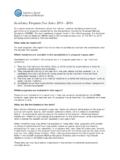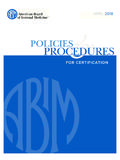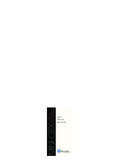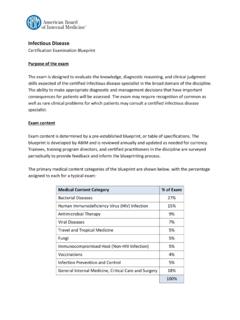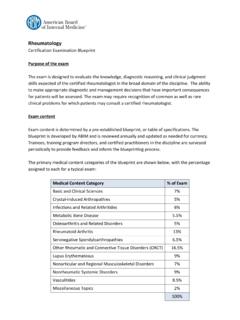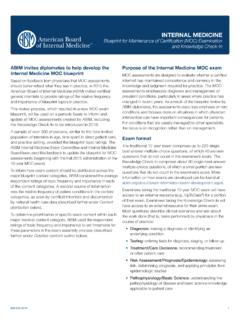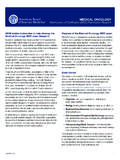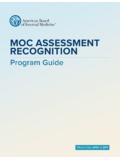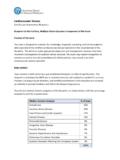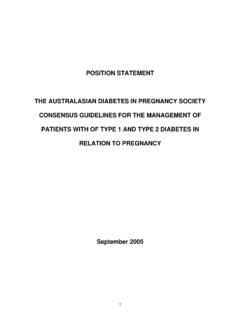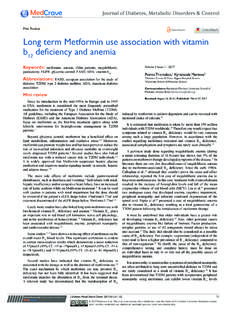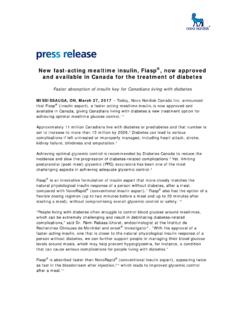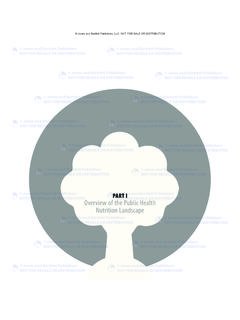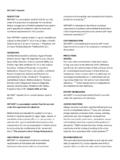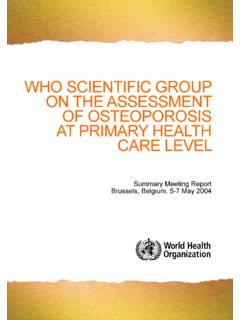Transcription of internal medicine - CERT - January 2018 - abim.org
1 internal medicine Certification Examination Blueprint Purpose of the exam The exam is designed to evaluate the knowledge, diagnostic reasoning, and clinical judgment skills expected of the certified internist in the broad domain of the discipline. The ability to make appropriate diagnostic and management decisions that have important consequences for patients will be assessed. The exam may require recognition of common as well as rare clinical problems for which patients may consult a certified internist. Exam content Exam content is determined by a pre established blueprint, or table of specifications. The blueprint is developed by abim and is reviewed annually and updated as needed for currency. Trainees, training program directors, and certified practitioners in the discipline are surveyed periodically to provide feedback and inform the blueprinting process.
2 The primary medical content categories of the blueprint are shown below, with the percentage assigned to each for a typical exam: Medical Content Category % of Exam Allergy and Immunology 2% Cardiovascular Disease 14% Dermatology 3% Endocrinology, Diabetes, and Metabolism 9% Gastroenterology 9% Geriatric Syndromes 3% Hematology 6% Infectious Disease 9% Nephrology and Urology 6% Neurology 4% Obstetrics and Gynecology 3% Medical Oncology 6% Ophthalmology 1% Otolaryngology and Dental medicine 1% Psychiatry 4% Pulmonary Disease 9% Rheumatology and Orthopedics 9% Miscellaneous 2% Total 100% Every question in the exam will fall into one of the primary medical content categories shown above. There are also other important areas that are addressed in conjunction with this medical content, and these areas are called cross content categories.
3 Not all questions have a cross . content classification; the cross content categories are shown in the following table: Cross Content Category Relative Percentage Critical Care medicine 10% Geriatric medicine 10% Prevention 6% Women's Health 6% Clinical Epidemiology 3% Ethics 3% Nutrition 3% Palliative and End of Life Care 3% Adolescent medicine 2% Occupational medicine 2% Patient Safety 2% Substance Abuse 2% Exam format The exam is composed of multiple choice questions with a single best answer, predominantly describing clinical scenarios. Questions ask about the work done (that is, tasks performed) by physicians in the course of practice: Making a diagnosis Ordering and interpreting results of tests Recommending treatment or other patient care Assessing risk, determining prognosis, and applying principles from epidemiologic studies Understanding the underlying pathophysiology of disease and basic science knowledge applicable to patient care Clinical information presented may include patient photographs, radiographs, electrocardiograms, recordings of heart or lung sounds, and other media to illustrate relevant patient findings.
4 A tutorial including examples of abim exam question format can be found at The primary medical categories can be expanded for additional detail to show topics that may be covered in the exam. Each primary medical content category is listed below, with the percentage of the exam assigned to this content area. Below each major category are subsection topics and their assigned percentages in the exam. Please note: The percentages below describe content of a typical exam and are approximate; actual exam content may vary. 2. Allergy and Immunology 2% of Exam Anaphylaxis <2% Aspirin idiosyncrasy Stinging insect hypersensitivity Desensitization therapy Serum sickness Undifferentiated anaphylaxis Asthma <2% Exercise and cold induced asthma Allergic bronchopulmonary aspergillosis Nasal polyps and aspirin sensitivity Occupational asthma Asthma and pregnancy Asthma mimics (including vocal cord dysfunction)
5 Undifferentiated asthma Rhinitis, sinusitis, conjunctivitis <2% Allergic rhinitis Acute and chronic sinusitis Allergic conjunctivitis Upper airway cough syndrome Food allergy <2% Urticaria and angioedema <2% Hereditary angioedema Drug induced urticaria and angioedema Transfusion related urticaria or anaphylaxis Contrast related allergy Skin disorders <2% Atopic dermatitis Contact dermatitis Drug allergy other than drug induced urticaria and angioedema <2% Primary immunodeficiency disorders <2% Antibody deficiency (common variable immunodeficiency) Cellular immunodeficiency other than human immunodeficiency virus (HIV) infection Complement deficiency Primary humoral immunodeficiency Allergic complications of transfusions <2% Hemolytic transfusions reactions Transfusion related acute lung injury Transfusion related urticaria and anaphylaxis Autoimmune systemic disorders (including IgG4 related disorders) <2% Mastocytosis Allergic interstitial nephritis Eosinophilic esophagitis 3.
6 Eosinophilic pneumonia Eosinophilic granulomatosis with polyangiitis (Churg Strauss syndrome) Hypersensitivity pneumonitis Cardiovascular Disease 14% of Exam Hypertension (NOTE: This total includes the Hypertension content 5% listed under Endocrinology, Diabetes, and Metabolism; Nephrology and Urology) Essential hypertension Renal (including renal parenchymal, renovascular) Coarctation of the aorta Hypertensive urgency and emergency Undifferentiated hypertension Pericardial disease <2% Pericarditis Pericardial effusion Constrictive pericarditis Ischemic heart disease <2% Stable angina pectoris Acute coronary syndrome (ACS) ACS complications Heart failure from ischemic cardiomyopathy Evaluation of undiagnosed chest pain Other ischemic heart disease (coronary artery disease, spasm) Dysrhythmias and conduction defects <2% Conduction defects Bradyarrhythmias Tachyarrhythmias Other dysrhythmias (cardiac resuscitation)
7 Congenital heart disease in adults <2% Atrial septal defect and patent foramen ovale Bicuspid aortic valve Other congenital heart disease (patent ductus arteriosus, ventricular septal defect, pulmonic stenosis) Valvular heart disease <2% Aortic stenosis Aortic regurgitation Mitral regurgitation Mitral stenosis Prosthetic heart valve Myocardial disease <2% Heart failure with preserved ejection fraction (HFpEF) Myocarditis Hypertrophic cardiomyopathy with and without obstruction 4. Restrictive cardiomyopathy Dilated cardiomyopathy Cor pulmonale Undifferentiated myocardial disease Cardiac tumors <2% Endocarditis and other cardiovascular infection <2% Endocarditis Infections of the pericardial space Endocarditis prophylaxis Undifferentiated cardiovascular infection Vascular disease <2% Carotid artery disease Aorta Peripheral arterial disease Pulmonary vascular disease Venous disease of the lower extremities Superior vena cava syndrome (not due to cancer) Syncope <2% Neurocardiogenic syncope (vasovagal syncope) Situational syncope (including cough syncope, micturition syncope)
8 Postural hypotension Preoperative consultation <2% No testing required Testing indicated Lipid disorders <2% Antithrombotic therapy in cardiovascular disease <2% Miscellaneous cardiovascular disease (physical examination <2% findings, murmurs) Dermatology 3% of Exam Dermatitis (eczemas) <2% Atopic dermatitis Contact dermatitis Photodermatitis Stasis dermatitis Hand dermatitis Drug eruptions Nummular dermatitis Exfoliative dermatitis (erythroderma, not including mycosis fungoides) Seborrheic dermatitis Dermatologic immunology <2% Urticaria and angioedema Leukocytoclastic vasculitis 5. Vascular dermatoses <2% Erythema multiforme Erythema nodosum Telangiectasia Leg ulcers Acne and rosacea <2% Acne vulgaris Rosacea Papulosquamous dermatoses <2% Psoriasis Pityriasis rosea Lichen planus Skin and soft tissue infections <2% Dermatophytes Herpes zoster and varicella Viral exanthems other than varicella Cellulitis Necrotizing soft tissue infections and gas gangrene Lymphadenitis and lymphangitis Ectoparasites (lice, scabies, and others) Vesiculobullous dermatoses <2% Pemphigus vulgaris Dermatitis herpetiformis Pigment disorders <2% Vitiligo Melasma (chloasma)
9 Acanthosis nigricans Xeroderma pigmentosa Photosensitivity dermatoses <2% Porphyria cutanea tarda Photodermatitis Alopecia <2% Nodules and tumors of the skin <2% Seborrheic keratosis Actinic keratosis Warts, corns, and skin tags Squamous cell carcinoma of the skin Basal cell carcinoma of the skin Melanoma and nevi Mycosis fungoides Other nodules or tumors of skin (dermatofibroma) Nutritional disorders, cutaneous manifestations <2% Vitamin C deficiency and scurvy Niacin deficiency 6. Other nutritional disorders of skin Disorders of the nails <2% Environmental injury of skin <2% Frostbite Burns Pressure ulcers <2% Undifferentiated dermatology <2% Endocrinology, Diabetes, and Metabolism 9% of Exam Adrenal disorders <2% Primary aldosteronism and mineralocorticoid excess Adrenal insufficiency Pheochromocytoma Thyroid disorders <2% Hyperthyroidism Hypothyroidism Thyroiditis (not Hashimoto's or peripartum) Thyroid nodules and thyroid cancer Euthyroid sick syndrome Thyroid storm Hypertension (NOTE: This total includes the Hypertension 5% content listed under Cardiovascular Disease.)
10 Nephrology and Urology) Essential hypertension Renal artery stenosis Cushing's disease Lipid disorders <2% Hypercholesterolemia Hypertriglyceridemia (not including chylomicronemia) Chylomicronemia syndrome Diet and hyperlipidemia Ovarian disorders and female reproductive health <2% Polycystic ovary syndrome Amenorrhea Ovarian cancer Testes and Male reproductive health <2% Male hypogonadism Male infertility Erectile dysfunction Testicular carcinoma and tumors Gynecomastia Diabetes mellitus <2% Type 1 diabetes mellitus Type 2 diabetes mellitus 7. Diabetes mellitus and pregnancy Complications of diabetes mellitus Disorders of calcium metabolism and bone <2% Hypercalcemia Hypocalcemia (not including vitamin D deficiency) Hyperphosphatemia Hypophosphatemia Paget's disease Osteoporosis Vitamin D deficiency and osteomalacia Renal osteodystrophy Hypothalamic disorders <2% Anterior pituitary disorders <2% Pituitary tumors Hypopituitarism Posterior pituitary and water metabolism <2% Hypernatremia Hyponatremia Endocrine tumors and endocrine manifestations of tumors <2% Insulinoma Vasoactive intestinal peptide (VIP) secreting tumors Zollinger Ellison syndrome (gastrinoma) Glucagon secreting tumors Carcinoid syndrome Malignancy associated hypercalcemia Ectopic adrenocorticotropic hormone (ACTH)
